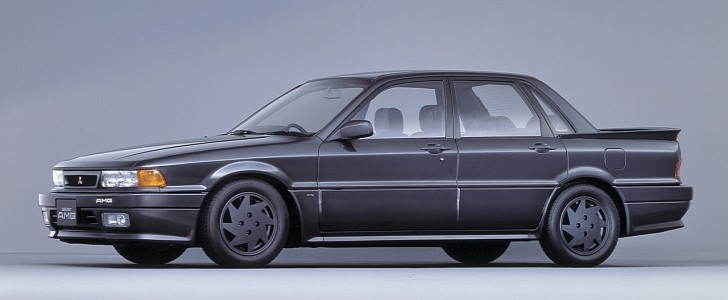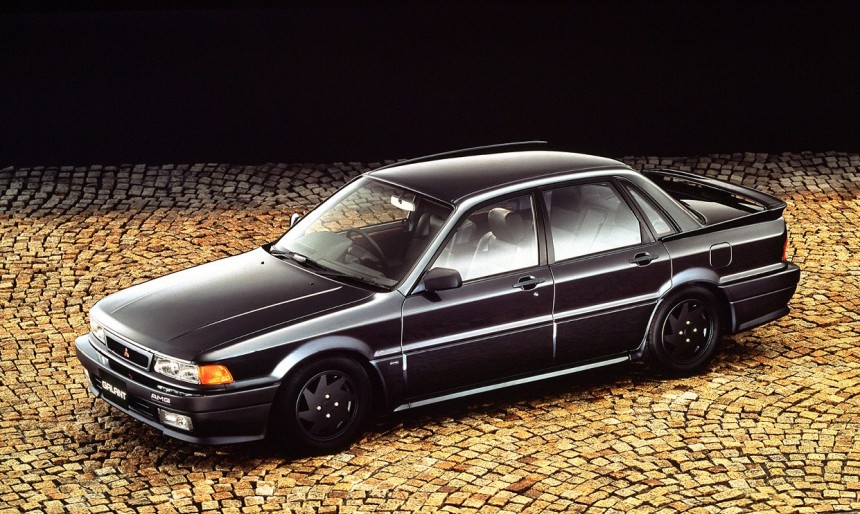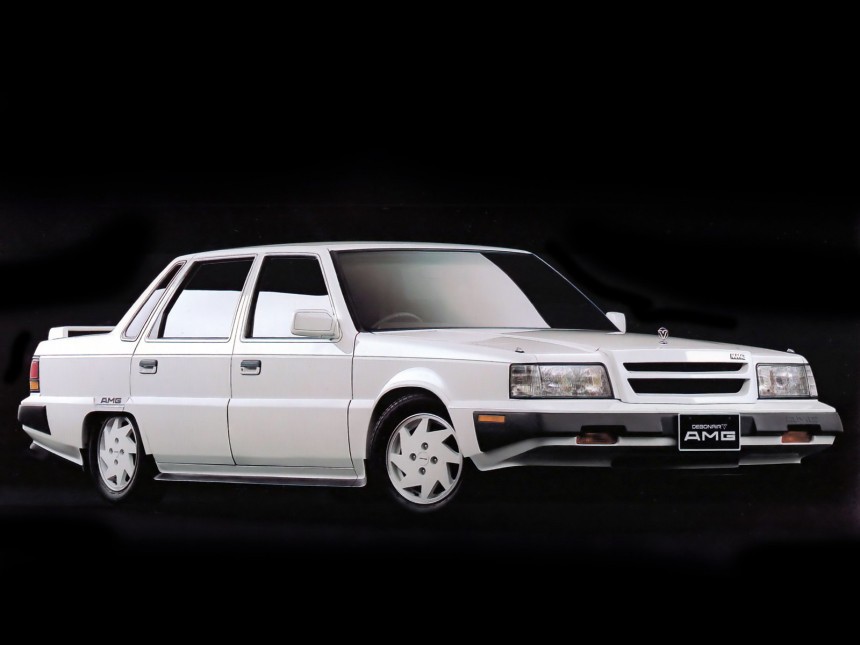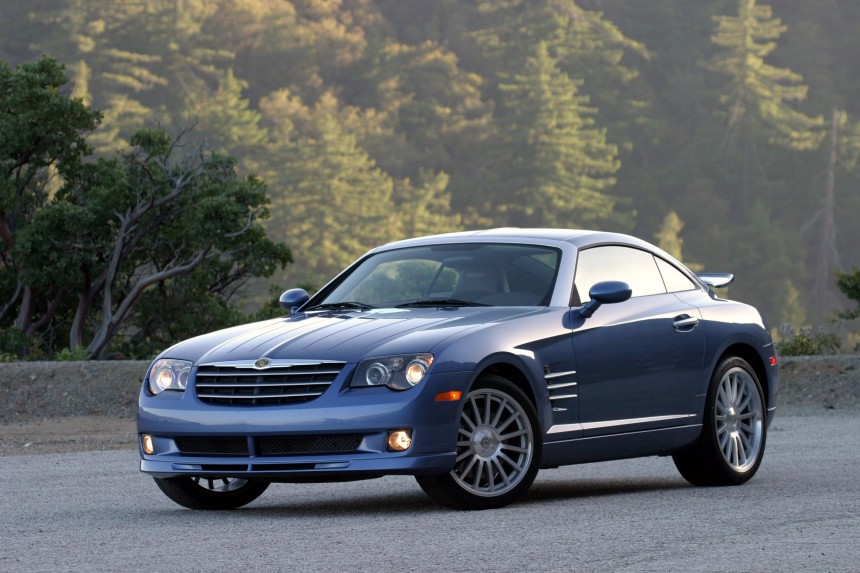AMG is now famous for developing high-performance versions of Mercedes-Benz cars. It's been doing it since the 1970s, long before Mercedes acquired the brand. But the Affalterbach-based brand also provided engine upgrades to other manufacturers. Pagani is by far the most iconic, but did you know that AMG also tuned cars for Mitsubishi and Chrysler?
AMG started out as a racing engine manufacturer in 1967. It started offering upgrades for Mercedes-Benz models in 1971 and in 1990 it signed a partnership with the German brand. Daimler acquired a controlling interest in AMG in 1999 and became the sole owners of the operation in 2005.
Right before AMG and Mercedes-Benz team-up officially in 1990 and long before it started providing engines to Pagani, the German shop developed a performance version of the... wait for it... Mitsubishi Galant. Can't remember what a Galant is? Well, it's a rather mundane nameplate that Mitsubishi produced from 1969 to 2012.
If it doesn't ring any bells, maybe you're more familiar with the VR-4, the high-performance, 4WD version of the Galant that was the basis for the company's participation in the World Rally Championship and led to the development of the more iconic Lancer Evolution.
Anyway, while Mitsubishi was already offering the VR-4 as a range-topping, performance version of the Galant, AMG created its own take on the four-door sedan. It was based on the GTi-16v model, powered by a naturally aspirated, 2.0-liter four-cylinder engine, and restricted to the Japanese market.
Rated at 145 PS (143 HP) stock, the four-banger was good for 170 PS (168 HP) once AMG upgraded the internals. Granted, it was impressively powerful when compared to the VR-4, which came with 241 PS (237 HP) on tap, but a solid upgrade nonetheless in the absence of turbocharging.
But more importantly, the Galant AMG was fitted with a unique body kit that included sportier front and rear bumper, a trunk lid spoiler, a lowered suspension, and alloy wheels. The interior was dressed in leather for a premium look and feel. The "germanized" sedan was produced from 1989 until 1991 and it's believed that only 500 units left Mitsubishi's Nagoya plant.
Oh, and before I forget. The Galant was actually the second Mitsubishi car touched by AMG. The German tuner was commissioned to enhance the second-generation Debonair sedan in 1986. But unlike the Galant, the Debonair only got an appearance package with no engine upgrades whatsoever. To this day, Mitsubishi remains the only Japanese brand to have offered a production car co-developed with AMG.
The company's vehicle of choice was the Crossfire, the two-door sports car that replaced the Prowler. The standard model was already powered by a Mercedes-sourced V6 engine, while the SRT version was fitted with the supercharged version of the same unit, taken from the 32 AMG variants of the C-Class and SLK.
Good for a solid 330 horsepower and 310 pound-feet of twist, the supercharged V6 enabled the Crossfire SRT-6 to hit 60 mph (97 kph) in 4.8 seconds, to go with a top speed of 155 mph (249 kph). The AMG package included a sportier suspension and bigger brakes, also taken from the Mercedes SLK 32 AMG, as well as a front fascia air dam, and a fixed rear spoiler.
The SRT-6 was easily the fastest and most powerful model in the Crossfire range, but it wasn't very successful with SRT gearheads, who complained about the lack of an American engine. Following a year of regular production in 2005, the SRT-6 was changed to special order only in 2006 and discontinued after a few more months.
Needless to say, the Mitsubishi Galant and Chrysler Crossfire are nowhere near as spectacular as the AMG-powered Paganis and Aston Martins, but they're an important piece in the AMG puzzle, just like the brand's early race-spec engines.
Right before AMG and Mercedes-Benz team-up officially in 1990 and long before it started providing engines to Pagani, the German shop developed a performance version of the... wait for it... Mitsubishi Galant. Can't remember what a Galant is? Well, it's a rather mundane nameplate that Mitsubishi produced from 1969 to 2012.
Mitsubishi Galant (and Debonair)
AMG's involvement with Mitsubishi happened in 1989, when the Japanese company was selling the sixth-generation Galant. Some of you may remember this car because the Eagle Talon and Plymouth Laser were based on it.If it doesn't ring any bells, maybe you're more familiar with the VR-4, the high-performance, 4WD version of the Galant that was the basis for the company's participation in the World Rally Championship and led to the development of the more iconic Lancer Evolution.
Anyway, while Mitsubishi was already offering the VR-4 as a range-topping, performance version of the Galant, AMG created its own take on the four-door sedan. It was based on the GTi-16v model, powered by a naturally aspirated, 2.0-liter four-cylinder engine, and restricted to the Japanese market.
But more importantly, the Galant AMG was fitted with a unique body kit that included sportier front and rear bumper, a trunk lid spoiler, a lowered suspension, and alloy wheels. The interior was dressed in leather for a premium look and feel. The "germanized" sedan was produced from 1989 until 1991 and it's believed that only 500 units left Mitsubishi's Nagoya plant.
Oh, and before I forget. The Galant was actually the second Mitsubishi car touched by AMG. The German tuner was commissioned to enhance the second-generation Debonair sedan in 1986. But unlike the Galant, the Debonair only got an appearance package with no engine upgrades whatsoever. To this day, Mitsubishi remains the only Japanese brand to have offered a production car co-developed with AMG.
Chrysler Crossfire SRT-6
This one's a bit more recent and probably not as obscure as the Galant. If you haven't been living under a rock in the 2000s, you probably already know that Daimler and Chrysler had a partnership back then. And it was this cooperation that put an AMG badge on a Chrysler.The company's vehicle of choice was the Crossfire, the two-door sports car that replaced the Prowler. The standard model was already powered by a Mercedes-sourced V6 engine, while the SRT version was fitted with the supercharged version of the same unit, taken from the 32 AMG variants of the C-Class and SLK.
Good for a solid 330 horsepower and 310 pound-feet of twist, the supercharged V6 enabled the Crossfire SRT-6 to hit 60 mph (97 kph) in 4.8 seconds, to go with a top speed of 155 mph (249 kph). The AMG package included a sportier suspension and bigger brakes, also taken from the Mercedes SLK 32 AMG, as well as a front fascia air dam, and a fixed rear spoiler.
Needless to say, the Mitsubishi Galant and Chrysler Crossfire are nowhere near as spectacular as the AMG-powered Paganis and Aston Martins, but they're an important piece in the AMG puzzle, just like the brand's early race-spec engines.















